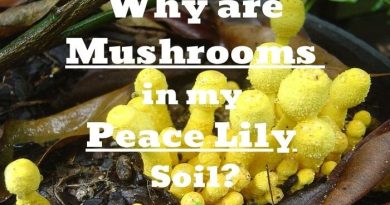Why is Dianthus Dying? (7 Causes & How to Prevent)
Dianthus can die from a variety of reasons but the most common ones are : fungus or pest infection. In this article we will present all the causes why is dianthus dying and how to prevent this from happening in case they end up being attacked or get infected.
Why is Dianthus dying?
The diseases that affect the dianthus flowers are very varied and should be taken into account especially by the producers of cuttings, as they are more sensitive to many of them and when the dianthus mother plant is sick, the diseases are transmitted to the cuttings and can cause the spread of it if dianthus are sold.
The main diseases and causes why dianthus are dying are listed below:
| Causes why Dianthus is dying: |
|---|
| 1. Rust |
| 2. Fusarium |
| 3. Alternaria alternata (Alternariosis) |
| 4. Botrytis (Gray rot) |
| 5. Aphids |
| 6. Snails |
| 7. Red Spiders |
1.Rust ( Uromyces caryophillinus )
Rust is a fungal disease that develops in Dianthus flowers at the leaf level , producing a series of pustules on the leaf and stem structure with a powdery appearance. Unfortunately if rust is left untreated can cause dianthus to die.
Although it is not frequent that it attacks flowers as such, it is capable of generating malformations in the dianthus plant that end up affecting the quality of the petals and can even cause the death of the dianthus flower.
It is common for its effects to be triggered when the plants are subjected to constant humidity in the environment. In addition, it is necessary that the environment temperature where the dianthus flowers is placed goes from 41°F to 82°F (5-28ºC).
The fungal mycelium spreads throughout the leaf and takes nutrients from the dianthus plant. It has a striking resistance, being capable of living for up to 6 months without having any host, which makes it more dangerous.
As a result, the affected tissue eventually dies. At present, numerous studies have been carried out that have allowed the creation of much more resistant dianthus species.
Hence, it is so essential to use healthy dianthus seedlings for planting and disinfect the land, as well as all the tools used. However, when undertaking a chemical fight, it is advisable to apply active ingredients such as azoxystrobin.
At the first appearance of stains, you should treat the plants immediately. Remove the affected dianthus leaves to prevent the disease from spreading further. Remove all dianthus leaves in the ground to minimize the possibility of the disease spreading.
Prior to the chemical fight, precautionary measures should be adopted to reduce the incidence of this disease, such as:
- selection of non-sensitive cultivars
- adoption of adequate cultural techniques such as heating and ventilation of the greenhouse to reduce humidity levels
- use of healthy cuttings
- planting with frames wide, reduction of nitrogen fertilizer
- preventive treatments with formulations such as chlorthalonil, mancozeb, bitertanol, myclobutanil, etc.
Luckily, this is one of the easiest fungal diseases to fight with natural recipes. Try using strong horsetail tea , a super potent medicinal herb.
Boil 1 liter of water, switch off, add 400 g of chopped mackerel, cover and wait for about 15 minutes. Strain, let cool and spray the dianthus plant, front and back, once a week for a month. If you can’t find horsetail, try making the chamomile syrup.
Taking into account the prevented methods above you can prevent dianthus for dying.
2. Fusarium
Of all the diseases that could attack the dianthus flower, fusarium is one of the most worrying because if left untreated can cause dianthus to die.
The reason is that the fungus that causes the disease penetrates from the roots , progressively affecting the entire structure of the dianthus plant.
Although at first the dianthus roots may look healthy, after the infection is installed, they end up rotting in a short time, ending the life of the dianthus flower.
Fusarium is a natural inhabitant of the soil. For this reason, we must bear in mind that if we have an infection, it is because we have imbalances in our cultivation. The weakest plants are the main targets of the fungus, making injured or stressed plants its main hosts.
The most common factors that cause fusarium disease on dianthus are: high temperature and moist soil with high acidity.
The problem is that it is a disease that will not be noticed until the damage is considerable. In addition to that, there are no corrective measures that are efficient to combat its appearance because it occurs at ground level.
In any case, there are preventive measures that could prevent the dianthus from dying, such as using resistant plants, quality irrigation water, disinfection of the substrate , etc. That a dianthus plant presents some damage due to the action of pests or diseases is a true tragedy.
To prevent and protect the dianthus from fusarium is it recommended to mulch the soil using either sand or gravel. Another thing to consider is the amount of fertilizer (nitrogen) used. It is indicated to use the proper fertilizer and avoid ammonia based fertilizer.
The only thing that can be done to control fusarium is to prevent the spread of the disease to the healthy dianthus flowers.
Make a visual inspection of the dianthus more often and if diseased flowers are found, dug them up and burn them.
Combining the prevention methods presented above will help you save the dianthus from this disease and prevent it from dying.
3. Alternaria alternata (Alternariosis)
Alternaria alternata is a disease that is capable of affecting both the leaves and the flower stems of the Dianthus , filling them with spots on their structure.
These spots differ from those caused by other diseases because they are usually purple.
Its radius of action is punctual at the beginning, but the most common is that the spots advance until they cover the entire surface of the dianthus making the leaves curl up and dry.
The high severity of alternariosis in dianthus is characterized by intense reduction of leaf area, drop in plant vigor, stem breakage and plant death.
There are different types of fungi that cause the appearance of alternaria, some of them operate during planting time, while others do so after harvest. Humidity is a determining cause for its appearance, as well as the steam that it produces when temperatures are very high.
Regarding the issue of prevention you should try to grow healthy dianthus and the use of resistant and healthy dianthus cuttings will be decisive. Fertilize the Dianthus flower using fertilizers that contain potassium and phosphorus and avoid excessive soil moisture.
However, it is also necessary to keep in mind that the use of fungicides will be key when there is no other solution.
Infection takes place if the temperature is above 50°F (10°C), with the optimum development temperature being 68-77°F (20-25°C).
To control this disease, the humidity level inside the greenhouse must be reduced and vapor condensation avoided. It is advisable to use healthy dianthus cuttings, of insensitive varieties and not very narrow planting frames.
4. Botrytis (gray rot)
Botrytis or Botrytis cinerea , also known as gray rot , is a very common disease in the vast majority of crops such as vegetables, vineyards, flowers like dianthus, as well as in plants intended for gardening.
Unfortunately is a very frequent disease of the dianthus, which can cause, in the first instance, the appearance of spots on dianthus flowers and fruits and, if the infection continues, they end up rotting the flower and cause the death of the dianthus.
In the ornamental garden, it affects flowers such as chrysanthemums, dahlias, dianthus, peonies, for example, while in the vegetable garden, it can infect onions, beans, lettuces, tomatoes.
The symptoms of Botrytis on dianthus flowers are characterized by: necrotic lesions, soft and watery gray rot or the presence of gray mycelium. The detection of one or more of these signs should alert us to the presence of this serious fungal disease.
Like any other disease, prevention is the key, so it is advisable to protect the flowers from high humidity .
Botrytis prevention methods are focused on avoiding the conditions that favor the entry and development of the fungus : high humidity and small cracks caused by birds, insects and other pests.
Using any measure that helps, such as good ventilation will be useful to stop the spread of the fungus.
Botrytis can remain on dianthus plant remains and dead plant tissue, until it finds favorable conditions for its development.
These conditions are:
- Formation of condensation that can be caused by rain, dew and high relative humidity inside the greenhouse.
- Diffused light.
- Strong changes in temperature (maximum of 35ºC, optimum of 15-25ºC and minimum near 0ºC).
In this sense, it is recommended to protect dianthus that are exposed to the weather elements, ventilate them and be very careful during pruning and handling of dianthus flowers , to avoid causing injuries or scratches.
Botrytis grows faster at lower temperatures with high humidity. For the indoor grower, the best prevention is to maintain a lower humidity in the growing environment, especially during the flowering stages.
Always in order to avoid excess humidity, prefer a morning watering. Water at the foot of the dianthus plant rather than spraying to avoid wetting the foliage as much as possible.
5. Aphids
Aphids occasionally appear on young dianthus shoots and leaves when the air is too dry. They leave behind a sticky substance on which rust fungi settle.
The aphid feeds on plant sap, so it sucks them from dianthus leaves and flowers causing the death of the plant.
It is a pest that has become very recurrent in dianthus crops, especially when they are kept during cold seasons.
In addition to sucking the vitality of the dianthus, they are also known to secrete a honeydew that facilitates the installation of the bold fungus. An aphid attack in low quantity can be controlled by using biological elements.
These become pale green and are often coated with honeydew, an aphid excretion product. These honeydew drops in turn form the breeding ground for the clove rust.
The ladybird is the most used insect for biological control of aphids such as the two-spot ladybird. If this method doesn’t work, it is necessary to proceed to chemical action.
However, it must be taken into account that their action is not detrimental to the flowering or to the other representatives of the fauna characteristic of the place.
It is the control done with the application of fast-acting insecticides. This is the preferred method of growers due to its ease of application and cost-effectiveness.
It is necessary, however, to take some care when choosing the products that will be used, always opting for the least aggressive to the environment and that facilitate the survival of predators of aphids, such as ladybugs.
6. Snails
They are pests that approach plants in a creeping way, they have similar behavior to snails, but without a shell. Various types of dianthus are considered flowers that snails do not eat.
Its appearance is frequent when the level of humidity in the environment is very high, perhaps after a prolonged period of rain.
In the case of dianthus, slugs are very harmful because they are capable of feeding on every part of the flower.
Slugs can be treated with extracts made from garlic and onion , so they become fairly easy to remove if caught early.
In any case, it is also possible to find molluscicide products on the market that will do an excellent job of achieving this goal.
7. Red Spiders
The effects of the red spiders , unlike the slugs, begin to be noticed when the relative environmental humidity begins to decrease.
Their attack, on the other hand, is manifested directly in the dianthus leaves , since they are in charge of sucking the sap from which they feed.
This action generates, as a consequence, small yellow dots on the dianthus leaves that weaken and cause them to die.
On the other hand, the red spider also produces a spider web that can be found located on the underside of the dianthus leaves, where it is common for them to travel. The good news is that spider mites can be treated by using agricultural products made with sulfur, so the dianthus plant can be sprayed.
It is also possible to increase the humidity in the area where the dianthus is established, especially when it is planted in closed areas.
How to prevent dianthus from dying
| Diseases | How to prevent dianthus from dying |
|---|---|
| 1. Rust | Spray with horsetail manure diluted to 20%. The lower diseased dianthus leaves are cut off immediately. |
| 2. Fusarium | Make sure the soil is well fertilized by adding compost or manure. Avoid high temperature and acidic soils. |
| 3. Alternaria alternata (Alternariosis) | Destroy the diseased dianthus plants. Reduce air humidity and less often spray plantings. |
| 4. Botrytis (gray rot) | Uproot and destroy affected dianthus plants. In the winter months, reduce the humidity of the air. |
| 5. Aphids | Treat dianthus from the start with fern manure and black soap or mineral oil. |
| 6. Snails | Place a mixture of wood ash and coffee grounds at the dianthus roots. |
| 7. Red Spiders | Treat it with slightly sulfur water. |
In this article we expose the more common diseases that affect dianthus flowers and cause them to die, describing their symptoms and recommended treatments by using different methods and products.
Among the diseases that affect the dianthus plant, fungi such as rust or fusarium and pests such as red spiders, thrips or aphids stand out.
Also, when the dianthus flowers wither you should remove them to prolong their flowering.
As with many perennials, pruning after winter is better. So the foliage can serve as a natural winter protection. You can cut off faded and dry shoots at any time.




